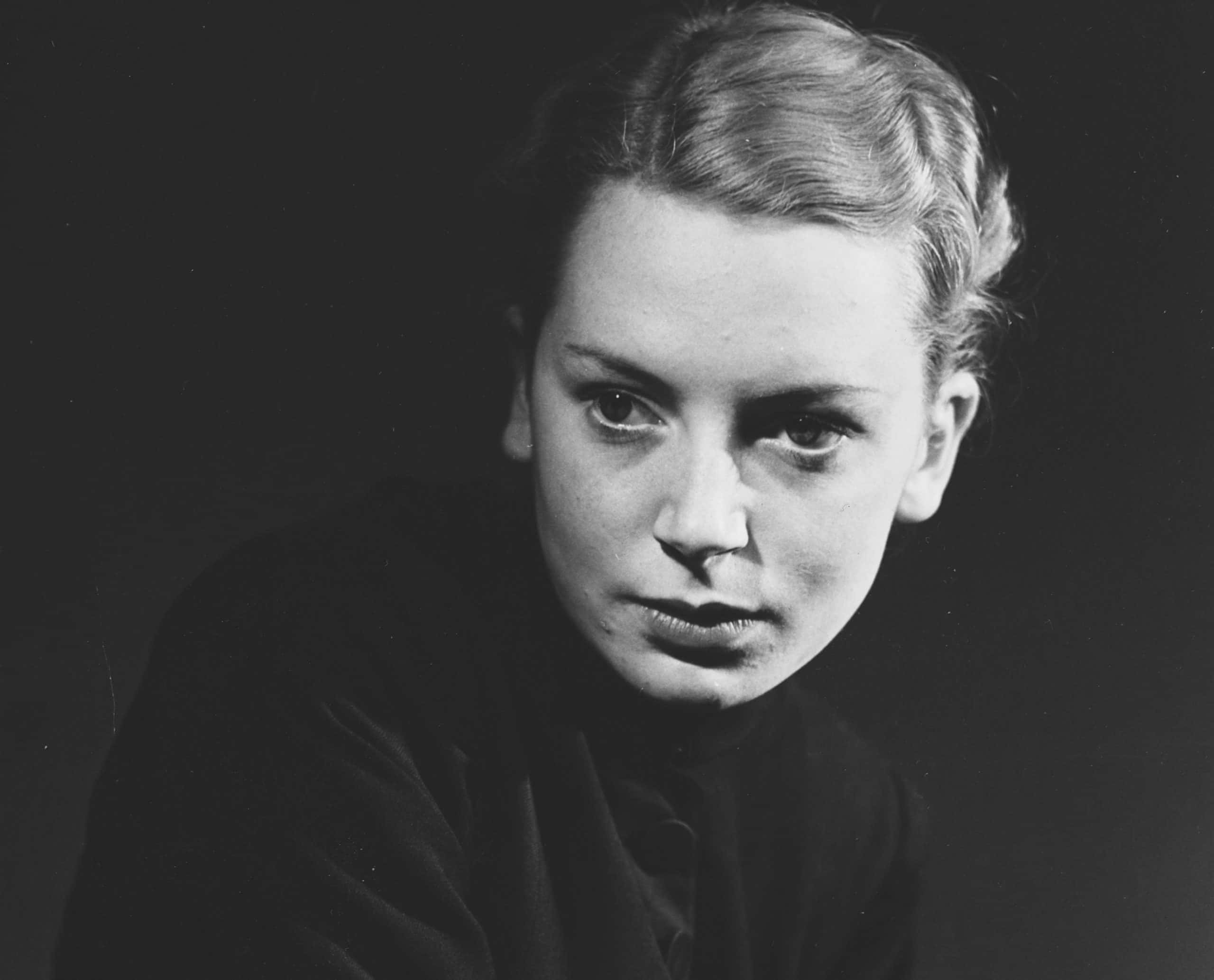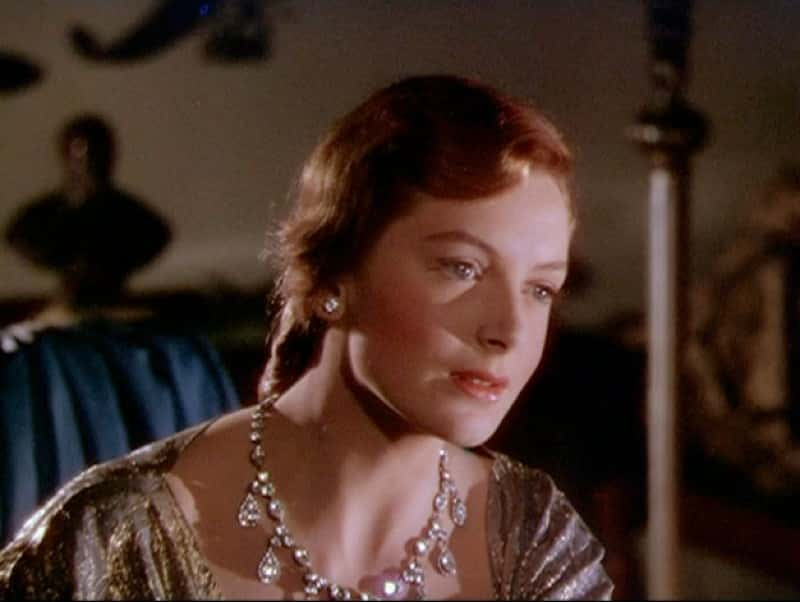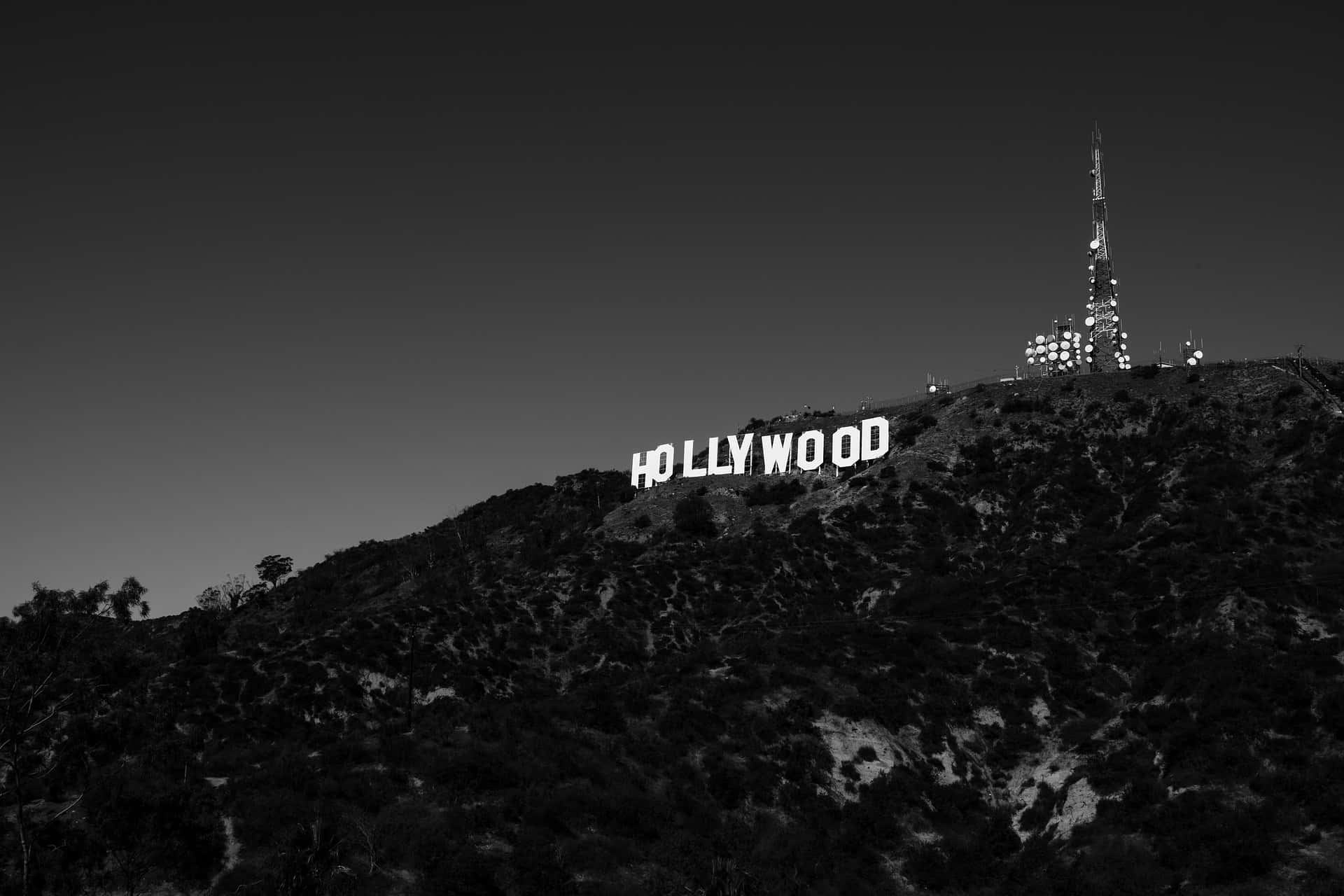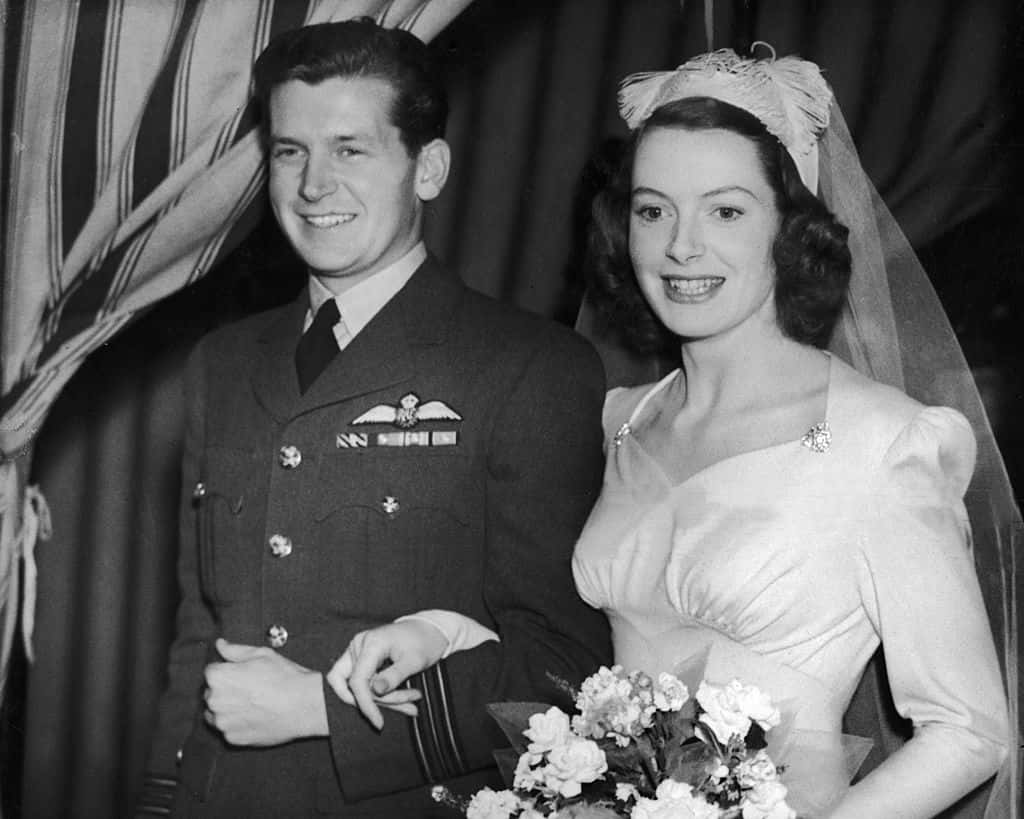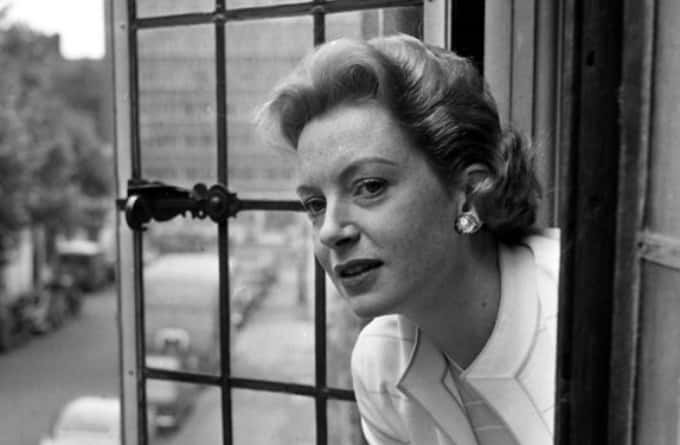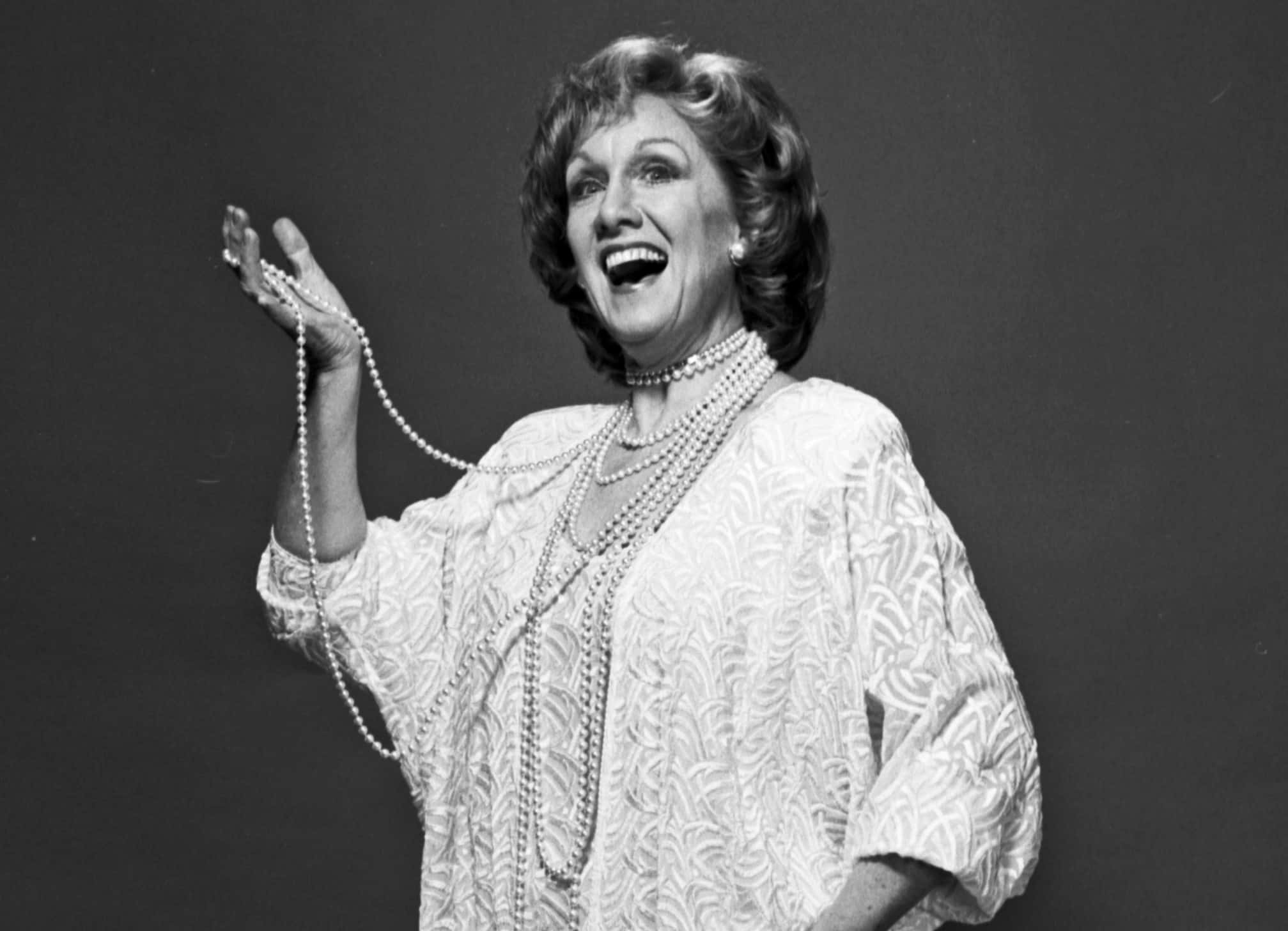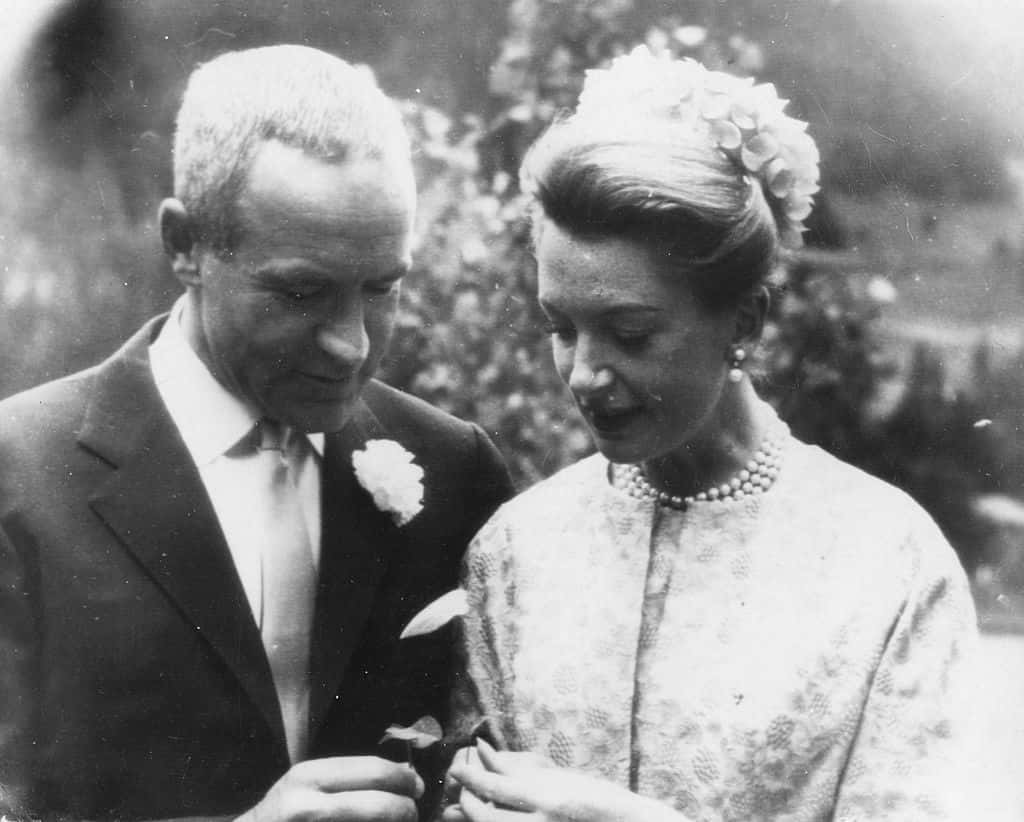This British beauty made a living playing prim and proper school teachers, nuns, and princesses. Deborah Kerr, however, longed for roles that would allow her to let her hair down. Well, when she found herself dressed only in a bikini and cavorting in the waves with a hunky Burt Lancaster, her career changed forever. But did her morals? Kerr publicly oscillated between portraying the virtuous and the spicy. But who was the real Deborah Kerr?
1. She Took It Lying Down
Deborah Kerr came into this world on September 30, 1921, in Glasgow Scotland as Deborah Jane Trimmer. But despite her illustrious future, her childhood was not a walk in the park. You see, Kerr had a very strict grandmother who concocted a somewhat cruel form of therapy for her. It seemed that young Kerr had poor posture and grandma had a ruthless solution.
She forced Kerr to spend extended periods of time lying on the cold hard floor. There’s evidence, however, that Kerr was a glutton for punishment. After all, she chose one of the most grueling vocations.

2. She Wanted To Dance
Lying on the ground was nothing compared to the physical trials Kerr endured throughout her first career: ballet. In addition to the pain and suffering associated with learning to dance on pointe, Kerr also faced another obstacle—her crippling insecurity. Kerr was extremely shy, so dancing in front of a crowd didn't come easy.
And that’s when a close relative suggested something even more difficult.
3. She Made A Switch
Kerr’s aunt, Phyllis Smale, saw Kerr struggling with her shyness and suggested acting. To her aunt, acting seemed like the best way for her niece to face her fears and overcome them, once and for all. Aunt Phylis just happened to work at a drama school in Bristol. Taking the advice to heart, Kerr left her dance shoes on the sidelines. But it wasn't an easy transition.
Dancing in front of an audience was one thing, but opening your mouth and speaking—well, it could’ve been the end for Kerr.
4. She Got Her First Break
In a surprising twist, acting didn't defeat Kerr at all. Instead, it set her free. She took to the stage quite naturally and even found some success in the theatre. But this was only the beginning. Before long, she got a call that would take her straight to the screen. She received an offer to play a supporting role in 1940’s Contraband.
This British film spy had some high-caliber performers and a team of directors who had already made a hit spy film. Her small role as a salesgirl would be a great start to Kerr’s film career. However, there was one huge problem.
5. She Didn’t Make The Cut
Kerr arrived on set, eager to prove herself—acting in front of the cameras for the first time. Unfortunately, we’ll never know how she did, and the reason for this is heartbreaking: The editor removed every frame of footage of Kerr from the finished film. Kerr quickly moved on to her next project and hoped for a better result...She should’ve hoped harder.
6. She Didn’t Measure Up
Kerr followed up her non-performance in Contraband with a hit. The film was an adaptation of the stage play Love on the Dole and Kerr caused quite a stir—but maybe not for the reason she wanted. One critic said she didn’t come close to Wendy Hiller, the actor who played the role on the stage. Yikes. This same critic did, however, have one positive thing to say about Kerr: He said that she was "a very pretty and promising beginner."
Down the road, however, that sad review—and the name Wendy Hiller—would come around to haunt her.
 Love on the Dole (1941), British National Films
Love on the Dole (1941), British National Films
7. She Got Sent Down
Kerr quickly followed Love on the Dole with a series of other British films. One of which was Major Barbara. In this film, she played Jenny Hill, who was a devout member of the Salvation Army church. To prepare for the role, the director gave her an outrageous demand: He told her to go work with the real Salvation Army. Kerr was soon helping the poor and hungry in London—all in the name of nailing the role.
But the dangers of research were nothing compared to the near-fatal disaster that went down during her next project.
 Major Barbara (1941), General Film Distributors
Major Barbara (1941), General Film Distributors
8. She Had A Near Miss
Kerr was filming 1942’s The Day Will Dawn—where she played the daughter of a Norwegian captain—when tragedy struck. Rex Harrison, of My Fair Lady fame, had dropped by for an after-shoot drink. While having a nice little chat, a German explosive went off in a nearby field. Dirt from the nearby vegetable garden covered Kerr and Harrison who, miraculously, had no severe injuries.
The odds of being that close to an explosion were pretty small—but not as small as landing her next role.
 Biography, Rex Harrison: The Man Who Would Be King (1998),Atlas Media
Biography, Rex Harrison: The Man Who Would Be King (1998),Atlas Media
9. She Rose Above The Others
Kerr's subsequent movie, 1943's The Life and Demise of Colonel Blimp, was remarkable for a number of reasons. First of all, Kerr got the job even though there was a huge number of actors vying for it—700! Secondly, the producers decided that her name meant a lot to the picture, so they did something unprecedented for an actress of her age: On the poster, they put her name above all the other performers. But that was just the tip of the iceberg.
In fact, there was something very unusual about this role that made it absolutely career-defining.
10. She Was A Multiple
There was a reason why so many actresses were eager to participate in The Life and Termination of Colonel Blimp. You see it wasn’t one role—it was actually three. Kerr ended up playing three different roles in the film. This gave her a chance to really show off her acting chops. In reality, though, the director hadn’t wanted her in the film at all.
 Flickr, Susanlenox
Flickr, Susanlenox
11. She Wasn’t Wanted
When casting for The Life and Journey of Colonel Blimp, the directing duo Michael Powell and Emeric Pressburger had a specific person envisioned for the multi-character female lead, and surprisingly, it was not Kerr. In fact, it was her nemesis Wendy Hiller—the same actor who one critic had said Kerr paled in comparison. Lucky for Kerr, Hiller had to back out of the role due to pregnancy.
As the consolation prize, Kerr really had to prove herself. And boy, she did not disappoint. Kerr acted up a storm and impressed the director—and then she took it one step further.
12. He Wanted Her In Another Way
The key minds behind The Life and Demise of Colonel Blimp might not have desired Kerr's involvement in the film, but one of them certainly had intentions for her that were a bit more intimate. In his autobiography, director Powell made a shocking confession: He’d bedded Kerr during the shoot. With a lover who was a celebrated producer, director, and writer, Kerr certainly had her career tied up.
In show business, however, things don’t always go as planned.
13. Her Affair Went South
Kerr's partner, Powell, was prepared to feature Kerr in his upcoming movie, A Canterbury Tale. He was quite enthusiastic about having Kerr work again with Roger Livesey, her previous co-star from The Life of Colonel Blimp. In the meantime, however, Kerr’s agent did something that destroyed this dream: He’d sold her contract to MGM studios in the US. This news turned Kerr's affair sour—and the romance unraveled in a horrible way.
14. She Confessed The Truth
It was likely that Kerr’s boyfriend was angry that Kerr was now under contract with MGM. After all, he was ready to reap the benefits of his new star's popularity. But then Kerr said something that amped up his anger to a whole new level. She told Powell the truth: that she’d be on the next plane to Hollywood the moment she got the call.
Powell took his revenge decisively and ended the affair, leaving Kerr open to a world of possibilities.
15. She didn't delay.
With Powell no longer in the picture, Kerr didn't spend any time wallowing; instead, she kept a watchful eye out for her next Prince Charming. In her search, she came across the very un-show businessy Anthony Bartley, who was a squadron leader for the Royal Air Force. The two married in 1945, and later, welcomed two daughters: Melanie Jane and Francesca Ann. This marriage, however, was off to a bad start.
It seemed that Bartley wasn’t fond of having a wife that made more money than he did—and Kerr was just getting started.
16. She Reunited
While Kerr was waiting for the call from the execs at MGM, she did more stage work in London’s West End and more film work in Britain. And that’s when something awkward happened. She landed a role in 1947’s Black Narcissus directed by none other than her ex-boyfriend, Powell. Even though their relationship was over, Powell was still intent on keeping Kerr in Britain, but then irony reared its ugly head.
17. She Got The Call
Powell had likely cast Kerr in Black Narcissus to keep her acting in British films and to keep her out of Hollywood. Unfortunately for Powell, the film was a big hit in both the UK and the US. Critics took notice of Kerr’s performance and that earned her the attention of Hollywood producers. Ironically, it was Powell’s Black Narcissus that finally sealed the deal
Kerr was Hollywood-bound. However, there was one thing standing in her way.
18. She Had To Convince Him
Before she could move to Hollywood, Kerr had to persuade her already jealous husband to give up his job and move to the US with her. It wasn’t that hard of a sell for a strange reason—his appetite. You see, England was still in post-WWII ration mode, which meant that there wasn’t much decent food to be had. Husband Bartley had to swallow his pride...so he could swallow some hearty American food.
Despite the promise of tantalizing cuisine, Bartley was still jealous of Kerr’s success—and what happened next, well, that pushed him right over the edge.
19. She Took Hollywood By Storm
Kerr arrived in Hollywood and literally hit the ground running. She was soon co-starring with acting greats like Clark Gable, Spencer Tracey, and Ava Gardner. But Kerr started to notice something odd. Her British accent and proper manners were getting her typecast. She was often playing very reserved women in American films, but knew that she could be so much more.
With her next film, she decided to make a statement by flaunting her wild side.
20. She Went Full-On Rom-Com
In 1950, Kerr took the lead in the romantic comedy Please Believe Me. In it, Kerr fights off the attentions of not one, not two, but three gentleman suitors. This role was a far cry from all the pious parts she’d previously played, and set Kerr’s career on a new path. Audiences, and more importantly producers, were finally seeing her as a sensual woman.
But to get more roles like this, she had to do something drastic.
21. She Had To Pay To Play
Kerr had definitely reached her limit when it came to the safe roles that MGM kept giving her. She wanted to be brash, even scandalous—but unfortunately, her accent, manners, and reputation were holding her back. If MGM couldn’t see her as something else, well then she had to get rid of MGM. Kerr ended up paying a colossal $1000 per week just to get out of her contract.
But once she was free from MGM, how would she forge a new career?
22. She Hired Help
Kerr quickly hired a new agent: Bert Allenberg. Allenberg could see in Kerr what MGM couldn’t—a sultry star. At the time, the hottest film project in the works was From Here to Eternity. The lead female role was a frank portrayal of an adulterous woman. Allenberg thought the role could be a game-changer for Kerr, but he had a huge obstacle to overcome: He had to convince the producers that Kerr was right for the part.
23. She Almost Missed The Boat
Unfortunately for Kerr, the role of Karen Holmes in From Here to Eternity had already been promised to Joan Crawford. Crawford was Hollywood royalty at the time, so Kerr and Allenberg started counting their losses. That’s when a miracle happened. Crawford was so high on her popularity that she’d made a staggering demand—one that left the role up for grabs.
 Wikimedia Commons
Wikimedia Commons
24. She Got A Second Chance
Joan Crawford had gotten about as big as a Hollywood star could get—and she had an ego to match it. For her role in From Here to Eternity, Crawford made an ultimatum: She would only work with her own cameraman. The studio gave that idea—and Crawford—a big pass. Kerr’s agent immediately got on the phone to get her name back in the running.
25. She Received A Hard No
Kerr’s agent, Allenberg called up Columbia head honcho Harry Cohn to petition Kerr for the role in From Here To Eternity. Cohn still couldn’t rid himself of the impression of Kerr as a prim and proper lady—or worse still—a nun. He didn’t want to ruin his film by having a prude play what was a very amorous character. The conversation ended badly, with Cohn just hanging up the phone.
At this point, all hope seemed lost...until the unexpected happened.
26. She Was A Joke
After Cohn hung up on Kerr’s agent, he wanted to share the joke with the From Here to Eternity director and writer. He described to the two men how ridiculous it would be to have the virtuous Kerr play the role of a sultry adulterer. To Cohn’s surprise, neither man laughed. In fact, the writer and director thought it was a great idea, and quickly convinced Cohn to hand the role over to Kerr.
The stage was set. Kerr could finally revamp her image. But first, she had to risk it all.
27. She Had Competition
By appearing in From Here to Eternity, Kerr had to go head-to-head with the blonde of all blondes: Marilyn Monroe. In fact, in some of the publicity stills for the film, some people thought Kerr was Monroe. Kerr had to make herself stand out, and she had to do it by laying it all on the line. Her acting had to speak for itself—but it only took one scene for her to captivate audiences.
28. She Took A Dive
In the original script, Kerr’s famous love scene with Burt Lancaster was meant to be shot with the actors standing up. Lancaster had the brilliant inspiration to take the scene horizontal. The director asked Kerr and Lancaster to change into bathing suits and start rolling around in the waves. Yes, Kerr had signed on to the film to change her reputation, but had she signed on for this?
29. She Hit The Beach
Kerr decided to literally dive into the beach scene with Lancaster. While the scene reeks of romance, the reality was something completely different. The two actors had to synchronize their romantic scene with the surf in order to achieve the maximum effect with the waves crashing behind them. Kerr later complained that by the end of the scene, she had tons of sand in places she’d rather not mention.
The logistics of filming the scene may have been a nightmare, but cavorting with Lancaster ended up being a dream come true.
30. She Had Real Passion
Even though Kerr and Lancaster were getting sand in all the wrong places, something very real happened on that beach. When it came to this famous duo, rumors abounded—and some say that they took their canoodling from the beach to the bedroom, where there was hopefully a little less sand. Their chemistry was undeniable, and it radiated off the screen.
Critics and audiences obviously liked what they saw, and Kerr received a best actress nomination from the Academy. Kerr had successfully made the transition from prim and proper to lewd and lascivious—but could she go back again?
31. She Hit The Mother-Lode
One thing Kerr hadn’t tried yet was a wholesome musical. In 1956 she scored a role in the mother-lode of musical theater: The King and I. The part of Anna had already become an iconic role on Broadway, so the stakes were high for Kerr to bring this character to life on the big screen. It turned out, however, that Kerr lacked the one thing that an actor playing Anna required.
32. She Fell Flat
Kerr was all set to play Anna in The King and I when it became clear she didn’t have the vocal pipes for the film's musical numbers. The producers wanted her for her name and her ability to play uptight characters in need of letting loose. The problem was that every time she opened her mouth to sing, her performance was downright cringeworthy. And that was when a disturbing truth came out.

33. She Was Second Choice
As it turned out, Kerr wasn’t the first person considered for the role of Anna—and it must’ve felt like deja vu all over again. Gertrude Lawrence, who the musical was originally written for, had already solidified the role on Broadway, and she was supposed to bring it to the big screen. During the Broadway run, however, tragedy struck.
Doctors gave Lawrence a shocking cancer diagnosis—and she passed during her final Broadway run. But the question remained: Why would they cast Deborah Kerr in such a beloved singing role?
34. She Had An Admirer
Deborah Kerr had a very important admirer on the cast of The King and I: Yul Brynner. He’d already immortalized the role of the King on Broadway, and really wanted Kerr playing opposite him. Brynner didn’t care that she had no singing voice, and left it up to the production team to come up with a solution to their off-key problem.
Their solution, however, was completely underhanded.
35. She Didn’t Sing
One of Hollywood’s worst-kept secrets was that many actors had their voices dubbed by professional singers. So, the production team for The King and I quietly contacted soprano-for-hire Marni Nixon to sing for Kerr. The two worked tirelessly side by side as some of the scenes required both singing and speaking. Kerr enjoyed working with Nixon and respected her talent and professionalism.
These warm feelings for Nixon led Kerr to do something very un-Hollywood.
36. She Demanded A Change
Kerr’s vocal “stand-in” had already worked for Hollywood legends such as Ingrid Bergman and Marilyn Monroe. Unfortunately for Nixon, the film producers wanted to keep this a secret. They wanted the audiences to feel their favorite stars could do it all—even when they clearly couldn’t. Kerr put a stop to this practice and made a demand: She wanted Nixon to receive full credit for her performance in The King and I.
This was a big win for Nixon—but Kerr faced a major loss.
37. She Melted
During the production of The King and I, much of the filming occurred under very bright lights. The lights were also extremely hot, and Kerr had to dance under them all day long. The heat was so intense that Kerr lost a whopping 12 pounds. During the filming, she dubbed herself the “melting Miss Kerr". Sounds like an idea for a new fad diet.
But the heat wasn’t the only problem on the set of The King and I...
38. She Went The Color Purple
In addition to the hot lights, Kerr also suffered from a dangerous wardrobe. The gowns she wore, designed by Irene Sharaff, scaled in at around 15 kg (33 lbs). They were so heavy and cumbersome that during the filmmaking of the “Shall We Dance” sequence, something horrible happened. As she danced around the room, her dress bruised her legs.
This film set wasn't without its perils, but it was Kerr's next project that wounded something much deeper—her ego.
39. She Proved Him Wrong
Kerr thought she had long since proven that she wasn’t always the prim and proper character that she often played. However, her next costar, Robert Mitchum, still saw her as a pious good girl. When they joined together to make the 1957 film Heaven Knows, Mr. Allison, Mitchum expected Kerr—who was playing a nun—to be a proper lady.
Well, she certainly proved wrong—and in the best way possible.
40. She Was Vulgar
Kerr changed her co-star's mind when he overheard her speaking to the director with a rather vulgar vocabulary. She certainly didn't hold back and gave him an earful of four-letter words. But that wasn't the best part. Mitchum just happened to be in the water when this happened and almost drowned laughing. However, when it came to Kerr's personal life, all light-hearted fancies flew out the window.
41. Her Success Took Its Toll
At this point, Kerr's rising star was unstoppable, but it did stop something else—her marriage. Her husband, Bartley, had already struggled with having a wife who had a higher income than he did. By 1959, Bartley had had it. The two quietly divorced, and, once again, Kerr found herself in need of a husband. She quickly fell into the arms of her next conquest—but he turned out to be a downright disappointment.
42. They Didn’t Agree
In 1960, Kerr quickly met and married author Peter Viertel, who had a pretty checkered past. He’d previously abandoned his first wife—who was pregnant at the time—for a French fashion model. But Kerr said her marriage to Viertel worked for two reasons: He was addicted to sports, and she couldn’t have cared less about them.
I guess opposites do attract, because, for some wild reason, this marriage stuck.
43. They Played Her On Repeat
In the days before Youtube, it was hard to get multiple views of your favorite scene in a movie. Kerr and Lancaster’s scene on the beach in From Here to Eternity was one that people wanted to see over and over again, but there was only one member of the public who had access: the projectionist. The scene kept getting shorter and shorter as projectionists across the country repeatedly snipped out frames for repeated viewing.
Kerr had successfully made the transition from prim and proper to lewd and lascivious—but could she go back again?

44. She Was Reluctant
In 1967, director Charles K. Feldman came to Kerr with a special offer. He desperately wanted her to be in a Bond movie, but Kerr wasn’t that interested. Feldman even assured her that her presence would only be required on set for 10 days of filming. When Kerr still hesitated, Feldman offered her a deal she couldn't refuse: Kerr would receive an enormous daily rate for every day they needed her past the ten days promised.
This was a spectacular deal, and Kerr benefited from it in the most glorious way possible.
45. She Raked It In
Under those spectacular conditions, Kerr agreed to appear in the James Bond comedy Casino Royale with David Niven. However, instead of 10 days on the set, Kerr was there for a staggering eight weeks—most of which she spent in her dressing room probably counting her money. She was 45 years old at the time, making her the oldest—and likely, best paid—Bond girl.
But Kerr wasn’t one to squander her hard-earned money.
46. She Invested Deep
At this time, Kerr was living in Switzerland with husband Viertel, but their life lacked one important thing: a place to swim. Kerr took her colossal earnings from Casino Royale and built a massive swimming pool. Kerr wasn’t one to miss an opportunity for a joke, so she named the pool “The Charles K. Feldman Memorial Swimming Pool” after the director who’d paid for it.
Kerr was at a point in her career where she could name her own salary—but her integrity still reigned supreme.
47. She Called It Quits
By the late 1960s, Kerr found herself disillusioned with the film industry. What she saw in the new era of films was excessive brutality, and, let’s be honest, a lot of women running around with their clothes off. Kerr wanted to do quality work, but the film-going public set the bar quite low. In 1968, Kerr made the most heartbreaking decision of all: She quit making movies.
She did, however, have room for one more project—and it was a staggering contradiction.
48. She Bared It All
The film was 1969’s Gypsy Moths and it reunited Kerr with From Here to Eternity wave romper, Lancaster. While the film was not overtly violent—unless you consider Lancaster's dramatic plunge from a plane to a squishy end—it did unveil something rather scandalous—Kerr's bare physique. Following this release, Kerr returned to a safe place—the stage, and eventually, television.
Sadly, with no movies in her future, Kerr had to say goodbye to her chances of ever winning an Academy Award.
49. She Set A Record
Some world records are for great accomplishments, while others just seem to point to impressive failures. Kerr’s record definitely belonged to the latter group. Throughout her career, the Academy honored Kerr with six Academy Award nominations, but the record she set was for something she never did—win. At that time, she was the most nominated actress without a single victory.
In 1994, however, something happened that would change all that.
50. She Accepted From A Fellow Loser
It was the 1994 Academy Awards and Glenn Close was on hand to award Kerr an honorary Oscar. Ironically, she received one of the longest standing ovations in Honorary Oscar history. But there’s even more irony coloring the picture: Glenn Close herself went on to outdo Kerr in Oscar losses, missing out eight times. Nevertheless, it was a huge highlight in Kerr’s career— something that would help her rest in peace.
51. She Made A Final Move
Kerr continued working on the stage and in television until tragedy struck: She received a diagnosis of Parkinson’s disease. Her ill health led Kerr to leave her life in Switzerland and Spain, and return to the UK to be with her daughters. She passed there in the fall of 2007. Strangely, within a few months, both her husband and biographer also passed. But that wasn't all.
In a further case of coincidence, they were all the same age—86 years old.



